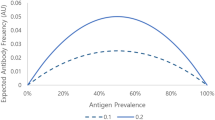Abstract
WE have reported that peritoneal cells (PCs) from unstimulated mice can, after 2 h of incubation in the appropriate medium, start to secrete anti-sheep erythrocyte (SRBC) antibodies1,2. We extended this observation by showing that PCs cultured in standard conditions for 4–6 d in the absence of SRBC, can form numerous haemolytic plaques, demonstrable by the ordinary techniques of local haemolysis (in Agarose, in liquid layer or in cellulose gum3). The immunological nature of this plaque-forming activity was established by the following criteria: complement dependency, inhibition by anti-mouse IgM serum and immunological specificity. Thus, we concluded3,4 that PCs of normal adult mice had been stimulated previously by an unknown immunogen sharing common or cross-reacting determinants with SRBC, and that tissue culture conditions would derepress the built-in capacity of these cells to produce antibodies. Treatment of autologous erythrocytes by the proteolytic enzyme bromelain revealed that normal mouse spleen cells regularly produce antibodies against their own erythrocytes5,6. This led us to investigate the behaviour of normal PCs towards SRBC or mouse red blood cells (MRBCs) treated by bromelain (BrMRBCs). We report here that mouse PCs in culture develop a plaque-forming activity against isologous BrMRBC as well as against SRBC, and we show that these two types of erythrocytes share some common antigen.
This is a preview of subscription content, access via your institution
Access options
Subscribe to this journal
Receive 51 print issues and online access
$199.00 per year
only $3.90 per issue
Buy this article
- Purchase on Springer Link
- Instant access to full article PDF
Prices may be subject to local taxes which are calculated during checkout
Similar content being viewed by others
References
Bussard, A. E., Science, 153, 887–888 (1966).
Bussard, A. E., and Lurie, M., J. exp. Med., 125, 873–892 (1967).
Gisler, R. H., Pages, J. M., and Bussard, A. E., Ann. Immun., 125 C, 231–238 (1975).
Nossal, G. J. V., Bussard, A. E., Lewis, H., and Mazié, J. C., J. exp. Med., 131, 894–916 (1970).
Cunningham, A. J., Nature, 252, 749–751 (1974).
De Heer, D. H., and Edington, T. S., Clin. exp. Immun., 16, 431–443 (1974).
Mishell, R. I., and Dutton; R.W., J. exp. Med., 126, 423–442 (1967).
Cunningham, A. J., Nature, 207, 1106–1107 (1965).
Ingraham, J. S., and Bussard, A. E., J. exp. Med., 119, 667–682 (1964).
Nossal, G. J. V., Lewis, H., and Warner, N. L., Cell. Immun., 2, 13–40 (1971).
Dodge, J. T., Mitchell, C., and Hanahan, D. J., Archs biochem. Biophys., 100, 119–130 (1963).
Cunningham, A. J., and Fordham, S. A., Nature, 250, 669–671 (1974).
Cunningham, A. J., Nature, 254, 143–144 (1975).
Hildemann, W. H., and Walford, R. L., Proc. Soc. exp. Biol. Med., 123, 417–423 (1966).
Author information
Authors and Affiliations
Rights and permissions
About this article
Cite this article
PAGES, J., BUSSARD, A. Precommitment of normal mouse peritoneal cells by erythrocyte antigens in relation to auto-antibody production. Nature 257, 316–317 (1975). https://doi.org/10.1038/257316a0
Received:
Accepted:
Published:
Issue Date:
DOI: https://doi.org/10.1038/257316a0
This article is cited by
-
“Natural” Antibodies to chicken MHC antigens are present in mice, rats, humans, alligators and allogeneic chickens
Immunogenetics (1980)
-
Autoimmume and polyclonal B cell responses during murine malaria
Nature (1978)
-
High proportion of Ig-producing cells making autoantibody in normal mice
Nature (1978)
-
T-cell mediated immunity towards antigen(s) on isologous erythrocytes
Nature (1977)
Comments
By submitting a comment you agree to abide by our Terms and Community Guidelines. If you find something abusive or that does not comply with our terms or guidelines please flag it as inappropriate.



